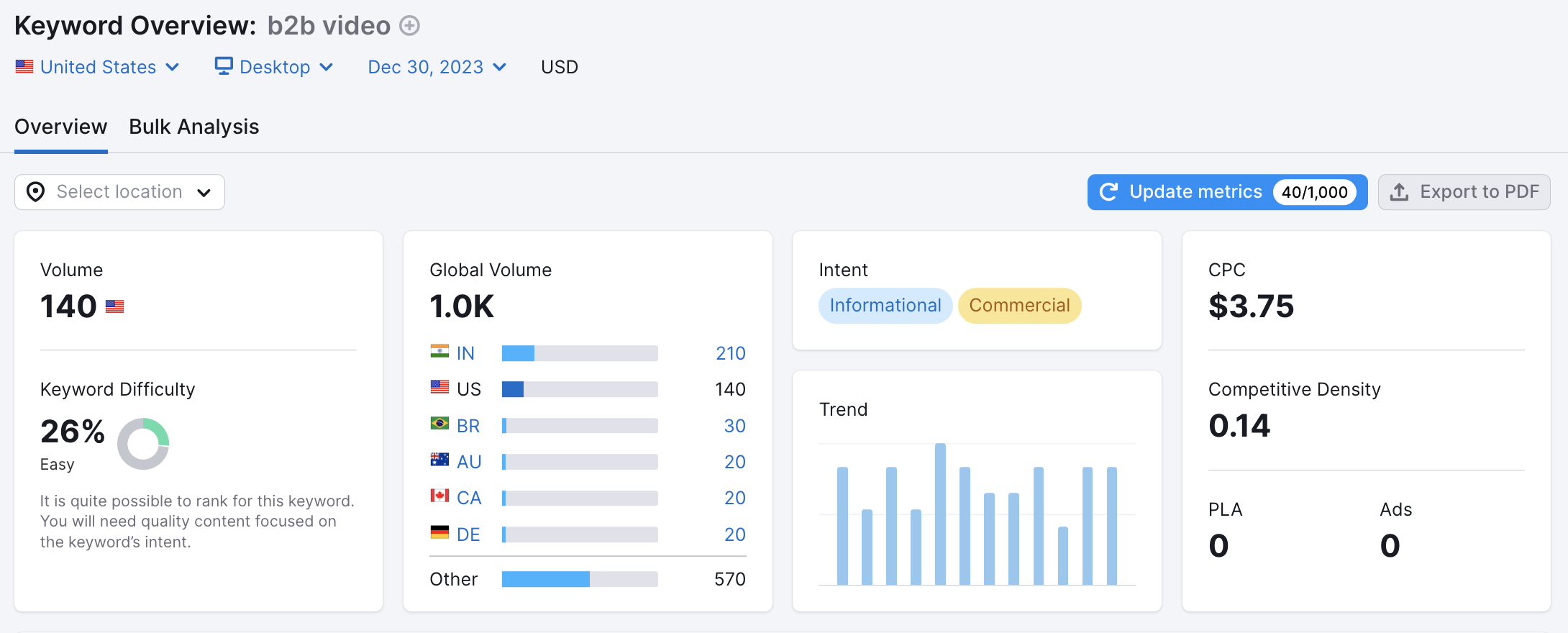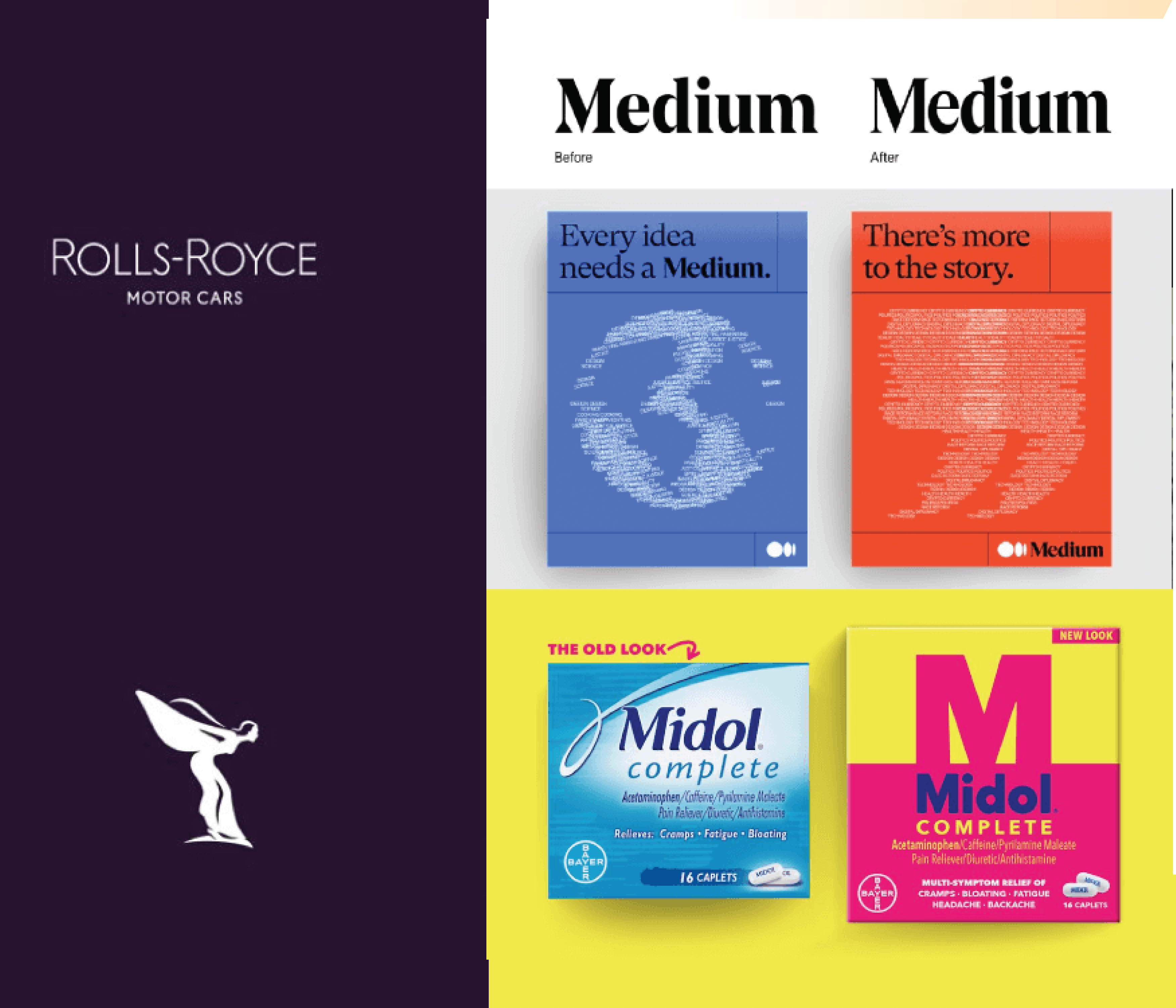Good SEO marketing is all about getting your brand’s valuable content in front of the right people to position your brand as a helpful resource. With the right keyword strategy, built on solid SEO keyword research, you can increase your SEO rankings, site traffic, brand visibility, and site authority—all of which help ensure that the people who want or need your type of product or service can actually find you on the Internet (ideally before they find your competitors).
That said, good SEO doesn’t just happen. As the Internet becomes more crowded (especially with the proliferation of AI-generated content), you need to thoughtfully craft content around the right keywords to get the best rankings. But how do you figure out the right keyword strategy? Today, we’re breaking it all down for you. While basic keyword research is a starting point, this article will guide you through advanced strategies that go beyond the basics for better SEO results.
 What Is a Keyword Strategy?
What Is a Keyword Strategy?
A keyword strategy is the process of researching and identifying the most relevant keywords for your brand, then crafting content to rank for those keywords. The focus keyword is the primary keyword or keyphrase that a page aims to rank for in Google, and it should be chosen carefully based on relevance and search potential.
Now, choosing the right keywords may seem like a simple task, but it can be tricky.
- Some marketers go too broad, using high-level keywords that get a lot of traffic but very few leads.
- Some go too niche, targeting obscure keywords that no one ever really searches for.
- Others simply guess which keywords they should target, or take the spray-and-pray approach and go for them all.
In each case, the results are less than spectacular. (BTW, if you fall into any of these camps, don’t beat yourself up too much. We’ve committed all of these sins at some point over the last decade.)
But remember: SEO is not just about getting your content in front of people. You want to get it in front of the right kind of people, those who will find value in what you have to say and may one day need your products or services. Understanding keyword intent is crucial when selecting keywords, as it helps ensure your content matches the goals and needs of your target audience. That’s why you need to do the legwork to identify the right keywords for your brand goals.
What Are the Main Types of Keywords?
First things first, when choosing the right keywords, you need to think about the user intent: why are they searching for that particular keyword? In general, there are four main categories of intent:
- Informational: People are looking for information about a subject.
- Navigational: People are looking for a specific website.
- Commercial: People are searching for information about brands, products, services, etc. Commercial keyword(s) refer to search terms with business or transactional intent, often used by users ready to make a purchase or take action.
- Transactional: People are looking to purchase or take an action (e.g., buy or subscribe).
Head keywords are broad, high-volume search terms that are often highly competitive, while keyword phrases combine head and long-tail keywords to address different search intents and competition levels.
As you craft your keyword strategy, you want to focus on your audience’s intent and how you can serve it. (Luckily, many SEO tools can identify what type of intent a user has when they search for a specific keyword, so you don’t have to guess.)
What Is the Best Mix of Keywords for Marketers?
To attract and convert the right audience, you want to curate a solid list of keywords that are relevant and attainable. Building comprehensive keyword lists that balance both head terms and long-tail keywords is essential for optimizing search engine ranking and effectively targeting search intent. Ultimately, you want to source these keywords from three core categories.
- Informational keywords your audience is interested in: Building your content strategy around these topic clusters is the best way to create a healthy mix of content that answers the big, evergreen questions that your audience will always want to know about (specifically in relation to your product, service, or industry).
- Commercial intent keywords relevant to your business: These are the specific keywords people are searching when they want to buy your type of product/service. Note: One of the biggest mistakes marketers make is assuming that the terms they use for their product/service are the same ones their audience uses. This is why it’s important to do proper research. You can generate keyword ideas from a variety of sources, including keyword research tools, Google Suggestions, forums, and niche websites.
- Keywords your competitors rank for: These are the keywords that your competitors have targeted, so you want to not only target them but ideally surpass them. This is always helpful to look at because they may be targeting keywords you would not have thought to consider.
Note: You can discover additional valuable keyword ideas based on competitor analysis, active online communities, and industry forums.
Remember: Your goal is to curate the right mix of keywords. That’s the best way to ensure your brand is a strong SEO competitor that will continue to climb the ranks—literally. That said, not every keyword will be advantageous to target. As you’re evaluating keywords within each of these categories, you also want to consider:
- Longtail keywords: These are longer variations of keywords (e.g., “brand campaign” vs. “beauty brand campaign examples”). While longtail keywords tend to have less search volume, they are more specific to your business and, ideally, have lower competition.
- Search volume: This is how popular the word is. The more people are searching for the keyword, the higher the volume. You want something with a decent search volume (but not so high it will be impossible to rank for). In fact, low-volume keywords can be advantageous in that they’re low-hanging fruit—fewer people are searching for them, so there is less competition to rank for them.
- Keyword difficulty: This is how difficult it is to rank for this word (due to its popularity). As Rand Fishkin of Moz points out, “I personally think of [Keyword Difficulty] scores in the 20-35 range as being quite low, 36-50 in the middle, 51-65 pretty tough, and 66-80 as very difficult.”
- Relevancy: The more relevant the keyword, the better it will be for your brand (e.g., “ice cream” vs. “gluten-free vanilla ice cream”).
This is the foundation of a truly successful keyword strategy, as it ensures your content matches what your audience is searching for, improving visibility and relevance.
How to Build a Strong Keyword Strategy
We know how much the right keyword strategy can improve your marketing. (In fact, we increased leads 78% in six months when we revised ours.) So we’re here to guide you through the process. Follow these simple steps to source and curate the best keywords for your brand and you’ll be on page one in no time.
Note: To do this, you’ll need access to keyword tools like Google Keyword Planner, Moz, Semrush, etc. To use Google Keyword Planner, you must first set up a Google Ads account. Google Ads data can also provide valuable insights for keyword research and help you analyze competitive PPC strategies. These tools will help you research keywords, assess how difficult it will be to rank, and offer you additional suggestions you may not have thought of.
STEP 1: Know your goals.
If you’ve created a comprehensive content strategy, you should know exactly what you’re trying to achieve, and your keyword strategy should support those larger business goals. (If you haven’t done that work yet, follow our guide to create a content strategy.)
STEP 2: Examine your personas.
Understanding your target audience—their search behaviors, preferences, and demographics—will help shape your keyword choices to better align with their needs.
In some ways, a keyword strategy is reverse-engineering your buyer’s journey, helping you identify:
- Who you’re trying to reach
- What information they’re interested in
- What search terms they use to find the information they want
- How users search for information on different platforms
The “who” is crucial, which is why you need to document clear personas that detail the demographic and psychographic attributes of the people you’re trying to reach. (Here’s how to create personas if you don’t have them already.) You can also use people search data from tools like Google Search Console to inform your keyword research by analyzing what users are actively searching for when they discover your website.
STEP 3: Research the keywords your audience is interested in.
Smart keyword research starts with understanding how your audience thinks: what they search, the language they use, and what they expect to find. That sounds simple, but it’s not just about the terms themselves. It’s about the motivation behind them.
Consider a quick example:
- “Best running shoes” signals research mode.
- “Buy Nike Pegasus 40” points to purchase intent.
- “Running shoes for flat feet” suggests a problem that needs a solution.
Fire up keyword tools like Google Keyword Planner, Ahrefs, or SEMrush to pull the data that counts: search volume, keyword difficulty, and what’s trending in your space right now. These tools give you fantastic visibility into what terms are picking up momentum and which ones are too competitive to hit first.
But here’s what many people forget: long-tail keywords carry real weight. They won’t deliver massive volume, but they bring targeted traffic and help you avoid grinding it out in crowded search engine results pages.
Now here’s where it gets interesting: Some of the best insights you can get come straight from your own data. Google Search Console and Google Analytics hold clear signals on how people find your site, which queries drive the most visits, and—most importantly—which keywords convert. That insight helps refine your keyword list and build content that maps to real intent. Think of it like tuning a playlist: you want to double down on the tracks that actually get played.
STEP 4: Gather a master list of keywords.
Start by compiling a list of all the keywords, subjects, categories, or themes your audience cares about. You probably already have a solid sense of what those are, but try seeing it from their side. What questions do they ask? What terms pop up in their search bar after hours? Use those keywords to map real intent, strengthen SEO, and focus your content on what actually drives action.
- Talk to your key stakeholders, especially your sales team. They know what customers are thinking about, looking for, and curious to know.
- Dig into Google Analytics to identify what terms people are using to find you now. (Check your traffic sources and related keywords.) This can also help you discover new keywords that are driving traffic to your site.
- Go to AnswerThePublic and type in any subject. It will generate a list of questions and related topics that people are asking about. Additionally, explore related search queries suggested by Google to uncover further keyword opportunities. Leverage keyword data from various tools to inform your research and optimize your keyword selection.
You’ll narrow down the list later, but first you want to identify every potential keyword under your umbrella. Pay special attention to identifying keywords that are seasonal or trending, as these can help you capture early traffic and improve your ranking.
Finally, analyze search queries from different sources to identify gaps not currently addressed by existing pages on your site.
STEP 5: Find keywords with commercial intent—and moderate keyword difficulty
Now it’s time to look at keywords through a different lens, specifically:
- Search intent: Choose “commercial” and “transactional.” A commercial keyword and a transactional keyword show strong buying signals—people comparing options or ready to purchase.
- Keyword difficulty (KD): Cap KD at 50% or lower. This flags terms you can realistically rank for. Gauge your chance of ranking by scanning the competition and your site’s authority. For example, a mid-tier SaaS site can win a KD 35 term if top results are smaller blogs.
- Volume: Keep keywords with at least 100 monthly searches. That ensures real demand and gives you room to grow traffic. A niche term at 150 searches can still drive pipeline if it maps to a high-intent offer.
Together, these filters surface low-hanging, rankable keywords that support your goals and match what people want at each stage of the buyer journey. If you can align landing pages to the target keyword and intent—messaging, headers, and CTAs—your rankings improve and conversions follow.
STEP 6: Look at keywords your competitors rank for.
Your SEO tool will likely offer the ability to compare your brand to your competitors to see what terms they’re ranking for. (If not, see Wordstream’s roundup of the best SEO competitor tools.)
This exercise is incredibly helpful in that it allows you to find keywords you may not have thought to target. To further outperform competitors, aim for featured snippets by providing clear, concise answers to common queries, increasing your chances of appearing at the top of search results.
Additionally, in the course of doing all of this research, you may also find gaps in your keyword strategy. For example, you might find a low-volume search term that your competitors aren’t ranking for. That’s an easy win that can help you gain more visibility quickly. You can then use internal linking to connect new content around these keywords to cornerstone pages, strengthening your site’s authority and SEO structure.
Also consider creating dedicated landing pages for high-value keywords to improve both your conversion rates and search rankings.
STEP 7: Refine your list.
Now it’s time to review your full list of potential keywords and prioritize which words you should target first. This may require more detailed research into things like search volume and keyword difficulty, but you generally want to identify the highest-priority keywords. As you review and narrow down your list, consider:
- Which keywords are most relevant to your audience?
- Which keywords do you want to establish your expertise in?
- Which keywords can you realistically rank for?
- Which keywords do you currently rank well for? (You may want to target related longtail keywords in these areas.)
- Which topics do your competitors not talk about?
- Which focus keywords will serve as the central theme for each piece of content?
Remember, too, that keyword strategy is half art and half science. Depending on your product or service, you may find your more generic keywords to be decent options. However, if they are too broad or too difficult to rank for, you may want to explore more specific terms. Luckily, your keyword tool will offer related keyword suggestions. These tools can also help you generate keyword phrases that combine both head terms and long-tail keywords, allowing you to address different search intents and competition levels.
For example, we followed this exact process to craft our own keyword strategy. One area we wanted to focus on was video marketing, as that is a core service we provide. However, as we researched the subject, we realized the term “video marketing” is already a popular keyword (and thus difficult to rank for). But as we dove into longtail keywords and applied various filters for search volume, keyword density, etc., we found the term “B2B video” to be a great candidate.

To rank for this word, we brainstormed ideas we knew would resonate with our audience. Having previously polled our email subscribers about their preferred type of content, we knew our audience particularly enjoyed marketing example roundups. So, we created the post 20 B2B Video Examples That Are Anything But Boring, which made it to the #1 spot for “B2B video,” as well as related terms like “B2B marketing videos” and “b2b video ideas.” Although tedious, doing the right keyword research helped us identify a previously missed opportunity and reach the exact audience we wanted.
When targeting a specific longtail keyword like this, however, it’s important to post relevant content that matches user intent. Our post worked because:
- It was relevant to our B2B-centric audience.
- It had both commercial and informational intent.
- It had a search volume above 100 (140).
- It had a low Keyword Difficulty score (26%).
- Some of our biggest competitors weren’t ranking for the term.
Again, it’s all about knowing your audience’s needs and wants.
Common Keyword Research Mistakes to Avoid
Keyword research trips up smart teams all the time. But there are a few mistakes that are more common than others:
- Chasing broad, high-volume terms: Just because it’s what everyone else wants doesn’t mean it’s what you should go for.
- Skipping user intent: A keyword may look great on paper, but what is the searcher trying to do? Compare? Buy? Learn?
- Misusing tools: This can also create more blind spots. If you’re pulling lists and sorting by volume only, or skimming SERP features and missing how Google rewrites the intent, or ignoring seasonality, recency, or shifts in language that impact how people search, you may be setting yourself up for failure.
- Limited competitor analysis: Analysis often stops at domain overlap, but you can go deeper. Scan top-ranking pages and map their content depth, structure, and CTAs. Note content formats that dominate (e.g., guides, calculators, templates). Identify “gaps with demand” (aka terms competitors rank for with thin coverage).
In the end, strong keyword research looks simple:
- Aim for relevance over raw volume.
- Write to intent, not to a list of terms.
- Keep tuning as search behavior evolves.
The goal isn’t grabbing every click. It’s connecting with the right visitor at the exact moment they’re ready to act.
How to Put Your Keyword Strategy to Work
Once you have your list ready, it’s time to hit the ground running to grab all those sweet, sweet rankings.
1. Generate fresh content.
Now you can brainstorm fresh content ideas to capture your audience’s attention. Focus on how you create content that aligns with your keyword research and user intent, ensuring each piece addresses specific search queries and audience needs. Again, think about the posts that have historically resonated with your audience, or what they might find most valuable. If you’re lacking inspiration, here are 30 prompts to get your creative ideas flowing.
2. Optimize old content.
One of the easiest ways to improve your SEO is to refresh your existing content. You’d be surprised how small updates can move rankings and conversions.
- Try alt keywords.
- Add new info.
- Refresh visuals.
- Refresh title tags and headers to align with search intent.
- Update internal links to strengthen relevance (especially as you create new content).
- Rework intros and CTAs to match the query and next step.
Luckily, tools like Yoast will help you optimize your content, flag what’s missing, and offer suggestions to improve SEO. We also find it helpful to create an optimization checklist to make sure you don’t forget anything.
3. Measure your keyword research success.
SEO without measurement turns into guesswork. So, after launching a keyword strategy, check if it’s actually working. Track the right signals, including:
- Rankings for priority keywords
- Month-over-month organic traffic growth
- Conversion rates tied to revenue outcomes
Google Analytics and Google Search Console can really help you out here. They show how people discover content, how they move through pages, and where they convert.
Now the useful part: review keyword performance on a regular cadence (we recommend every 4-7 months). Find the terms that pull in qualified traffic and the ones that drive real outcomes: form fills, demo requests, purchases, etc. This feedback lets you refine your content plan, update your target list, and invest in what actually delivers.
Remember: Your keyword strategy will evolve with your content strategy, so don’t get discouraged if you aren’t seeing the results you’d like. The more you track, the more you’ll identify ways to tweak, iterate, and improve. For example, you may find you need to target a keyword with a lower or higher search volume. Or you may find a different longtail keyword to be much higher converting than you realized.
Staying Up-to-Date with Keyword Research
Search behavior moves fast, so keep your process tight. Track core algorithm updates, note new features in your research tools, and watch how queries evolve across devices and contexts. AI Overviews and conversational search keep shifting the click path, so follow credible tests and reports, not hype.
Curious what’s about to trend? Use Google Trends to spot rising topics and seasonal swings that can lift a campaign or drain it. Social platforms (especially Reddit) act like real-time focus groups—scan comments, see common questions, and note down language your audience actually uses.
Get Expert Help with Your SEO Strategy
Of course, if you’re feeling stuck and need a little extra help with your keyword or content strategy, it’s always helpful to find a savvy partner to help you through it. If you need a little extra boost, find out what it’s like to work with us (or reach out directly). We’d love to help you become your own SEO success story.






This article provides a comprehensive and practical guide to building a strong keyword strategy, offering valuable insights and actionable steps for optimizing SEO and attracting targeted traffic.
wow! what a great post. And I am very excited to read coming next post like this information is very helpful.